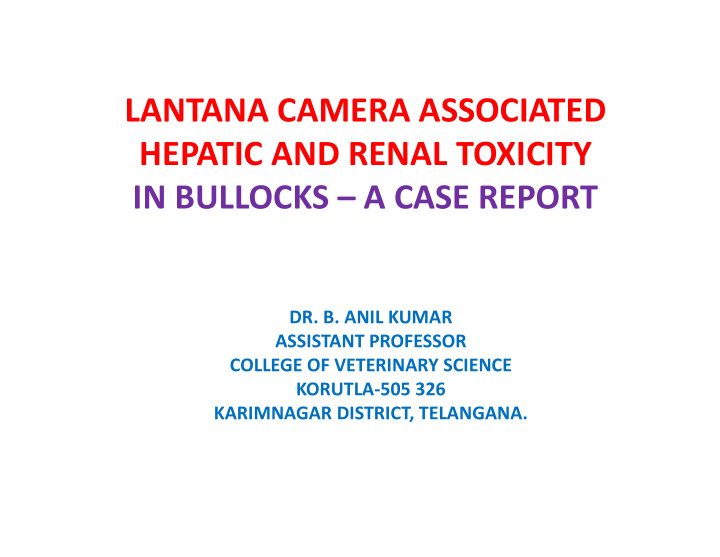



LANTANA CAMERA ASSOCIATED HEPATIC AND RENAL TOXICITY IN BULLOCKS – A CASE REPORT DR. B. ANIL KUMAR ASSISTANT PROFESSOR COLLEGE OF VETERINARY SCIENCE KORUTLA-505 326 KARIMNAGAR DISTRICT, TELANGANA.
Overview Lantana was introduced in India in 1807 as ornamental herb. • Species effected: cattle, sheep, goat, horses, pigs, wild animals, rabbit, • guinea pigs 1 st poisoning reported in Australia (Townville) in 1910 • 1 st Incidences of Poisoning in buffalo (Kangra valley, H.P.), sheep, goats • (Rampur bushier) Toxic principle: Lantadine A,B,C,D (Triterpanoid) effect bile canaliculi • Known to cause Hepatotoxicity, nephrotoxicity and photosensitization. •
Toxicodynamics Ingestion of plant Absorption from rumen and S I Liver Metabolism Secretion of metabolates in to bile Injury to bile canalicular membrane Cholestasis, hepatitis Retention of bilirubin, phylloerythrin and ruminal stasis Jaundice Photosensitization pH alkaline (NH 4 &N 2 ) Renal damage
Symptoms Anorexia • Ruminal motility ceases up after 6hr and atony seen after 24 hrs • Complete constipation/impaction • Rumination ceased • Dehydration • Icterus after 2-4 days • Skin changes due photosensitization • Death due to hepatic and renal failure •
Diagnosis History • Clinical sign • Laboratory test: • Liver: ALT, AST, ALP, GGT & Bilirubin kidney: BUN & Creatinine, HPLC: Diagnosis of lantadine in the ruminal content, peaks on • chromatogram 2.43 min and 7.01 min ( Narendra Vyas, and Ameeta Argal, 2014 ) Thin layer chromatography •
PARTICULARS OF OWNER & ANIMAL Case No. 69 & 70 Date: 11-07-2014 • Owner Particulars: S. Ravi, • Chaulamaddi Villaga, Korutla Mandal Karimnagar district, Telangana. Animal Particulars: • Species : Bovine Breed : ND Sex : Male (Bullock) Age : 10 years Colour : White
History Two Bullock were brought to the Teaching Veterinary Clinical Complex, • College of Veterinary Science, Korutla with the history of anorexia and voiding scanty faeces since 3 days . Owner has reported that 4 days back, unknowingly two bulls had entered • the near by village and were there for one entire day . Next day owner found them grazing on lantana plants. • From that day onwards they were not taking feed and voiding scanty • faeces. Owner has taken them to near by Veterinary hospital for 2 days but there • was no improvement. There treated with rumentorics and B-complex injections.
CLINCAL EXAMINATION Detailed clinical examination has revealed, • : 102 0 F Temp Pulse : 84/ minute Heart rate : 47 beats/ minute Resp. rate : 37/ minute C.M.M. : Icteric (Moreicteric in one animal) B.M.M. : Normal Rumen motility : Atony Rumen liquor pH: 8.0 Lymph nodes : Normal
General body condition : Lean and severely dehydrated Demeanor : Dull and very weak • Profuse frothy salivation also noticed • We have collected dung, urine and blood. • Faecal sample is negative for parasitic ova • Peripheral blood smear is negative for haemoprotozoans • Urine examination: • Colour : Deep yellow • Odour : Slight pungent • Hay’s test : positive for bile salts
SERUM ANALYSIS • ALT values (IU): 74.3 IU/micro lit. (14-38) • ALP values (IU): 235.3 IU/micro lit. (90-170) • BUN values (mg%): 41.26 mg (20-30) • Serum Creatinine (mg %): 4.39 mg % (1-2) • Serum Bilirubin (mg %): 0.84mg % (0.1-0.5) Indicating both hepatic and renal insufficiency. •
TREATMENT • Animals are treated with the following medication � Inj. DNS 5D @ 1350 mL i.v � Admin. of activated charcoal @1.0kg in 10 liters of water 1 st Day � Magnesium sulphate @50gram p.o � Inj. Histanil 20 mL i.m � Inj. Enrofloxacin 20 mL i.m � Inj. Melonex 15 mL i.m 5 Days � Inj. Belamyl 20 mL i.m � Rumentas bolus @ 4 boli daily for 3 days � Prescribed Liv-52 syrup @ 50 ml orally BID for 15 days.
• Bullocks started defaecating by 2 nd day and started taking green grass from 4 th day onwards and recovered fully by 7 th day.
Recommend
More recommend